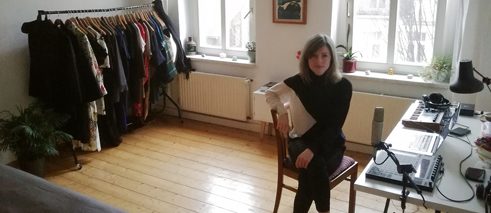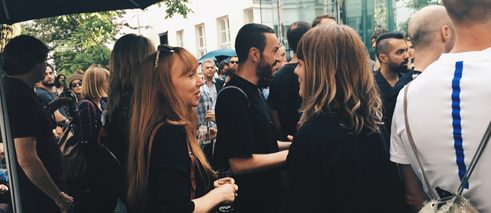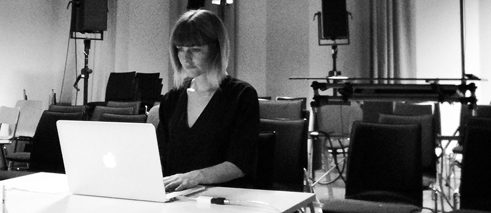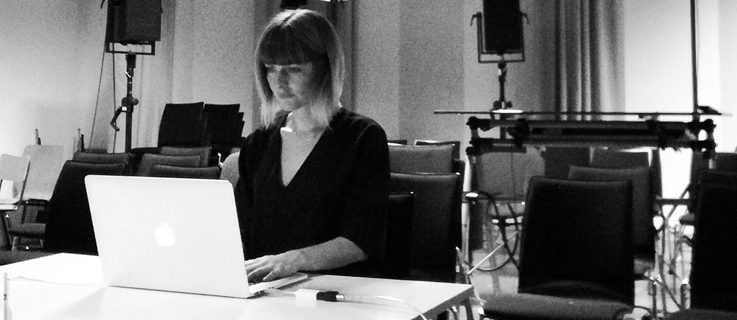In 2016 I moved to Weimar, a small city with big connections to German history. In addition to being the namesake of the interwar republic, Weimar was once the beloved locale of the 18th and 19th century intelligentsia (think Goethe, Schiller, Nietzsche, Liszt...). It later became the scene where the modernists of the 20th century gave rise to a new movement in art at Bauhaus. Weimar is also a monument to the darker side of Germany’s past with traces of the Nazi regime left behind in state buildings, as well as the presence of Buchenwald concentration camp near the city.
I moved to Weimar from London, following study in New Zealand, to take up postgraduate study at Bauhaus University. I had considered a Masters for some time and applied to Bauhaus because of its unique interdisciplinary media art program which included access to an electroacoustic music facility at the Franz Liszt Hochschule für Musik. It seemed a good fit given my interest in emerging technologies (in relation to new art practices), as well as my background in computer music and sonic arts. Central to the school’s philosophy is the Bauhaus ideology of the gesamtkunstwerk – ‘total work of art’ – emphasising the synthesis of different mediums.
At Bauhaus I’ve designed responsive audio for motion capture at the The Digital Bauhaus Lab with a team of 3D animators, I’ve composed multi-channel sound works for the 48 channel loudspeaker orchestra, and I’m currently experimenting with sound environments for virtual reality. I’ve also taken creative coding modules as well as DIY electronics labs, and there are always additional workshops and talks throughout the semester from visiting artists and professors. IKKM Bauhaus fellow and distinguished philosopher Rosi Braidotti recently gave a highly informative talk on her discourse around posthumanism and in 2017 the studio saw a visit from prolific electroacoustic music composer Francis Dhomont.
Audio: spectra_ephemera (pt. II), Amy Jean Barnett (Composer)
spectra_ephemera (pt. II)
Weimar, though small, is also an incubator for cross-disciplinary collaborative projects, extending well beyond the university with there are concerts in repurposed industrial and outdoor spaces. it is also home to the mysteriously infamous German record label
Giegling.
Audio: Kettenkarussell, Gate
The proximity of Germany to other major European centres and institutions is what makes these kinds of experiences possible and is one of the main reasons I chose to come here. It must also be noted that tuition is free in Germany, even for non-EU nationals, and Germany’s relative affordability (in some centres) makes it an ideal place for foreign students escaping inflated education costs elsewhere.
 In my 260 Euro all-inclusive WG/wohngemeinschaft zimmer (flatshare room) | © Amy Jean Barnett
In my 260 Euro all-inclusive WG/wohngemeinschaft zimmer (flatshare room) | © Amy Jean Barnett
The unique social conditions – cheap rents and empty spaces – in post reunification eastern cities like Berlin and Leipzig has enabled creativity to thrive and has supercharged Germany’s mythical attraction for creatives from all over the world. This collision of minds in an electric artistic atmosphere makes these cities particularly alluring – there are gallery openings, events, talks, discussions, exhibitions, festivals and concerts happening all the time, making for an inspiring environment.
 The author in conversation with Turner Prize winning sound artist Susan Philipsz at the vernissage of the 9th Berlin Biennale, 2016 | © Amy Jean Barnett
The author in conversation with Turner Prize winning sound artist Susan Philipsz at the vernissage of the 9th Berlin Biennale, 2016 | © Amy Jean Barnett
Additionally, there are opportunities through the university to showcase work at professional platforms and conferences. Last year I had the opportunity to participate in Next Generation 7.0 - a symposium that invites all university studios in Germany and neighbouring Germanic speaking countries to the
ZKM (Centre for Art & Media) in Karlsruhe for 5 days of new music performances, talks and discussions. The ZKM is a museum dedicated to media art and developed to ‘perpetuate classical arts in the digital age.’ It houses the
Sound Dome – a spatial sound facility with 47 speakers arrayed in a dome shape. This was an ear-opening experience!
Video: ZKM, next_generation 7.0, Open Panel Discussion
Open Panel Discussion
 The author composing in the SeaM (Studio for electroacoustic Music), Weimar. | © Amy Jean Barnett
The author composing in the SeaM (Studio for electroacoustic Music), Weimar. | © Amy Jean Barnett
Given New Zealand’s remoteness and small population my move to Europe was most definitely driven by a need for a wider context and bigger artistic community. As we are a small island nation in the South Pacific our access to cultural resources is limited and for this reason it’s difficult to compare New Zealand to Europe. New Zealand has its challenges but I’m optimistic for the future. A sign of this is that while in the past artists tended to leave and never look back, it appears that now many artists based internationally maintain and nurture their relationship with New Zealand (
Simon Denny,
Francis Upritchard are current examples). Last year 2 out of the 3 artists nominated for
Ars Viva, a prestigious German art prize for artists based in Germany, were New Zealanders –
Zac Langdon Pole and
Oscar Enberg – with Enberg winning. Such international artistic exchange and connection can only be seen as a positive thing for New Zealand’s cultural future, making Poneke – the Maori name for Port Nicholson (now known as Wellington) – part of a global artistic community.
